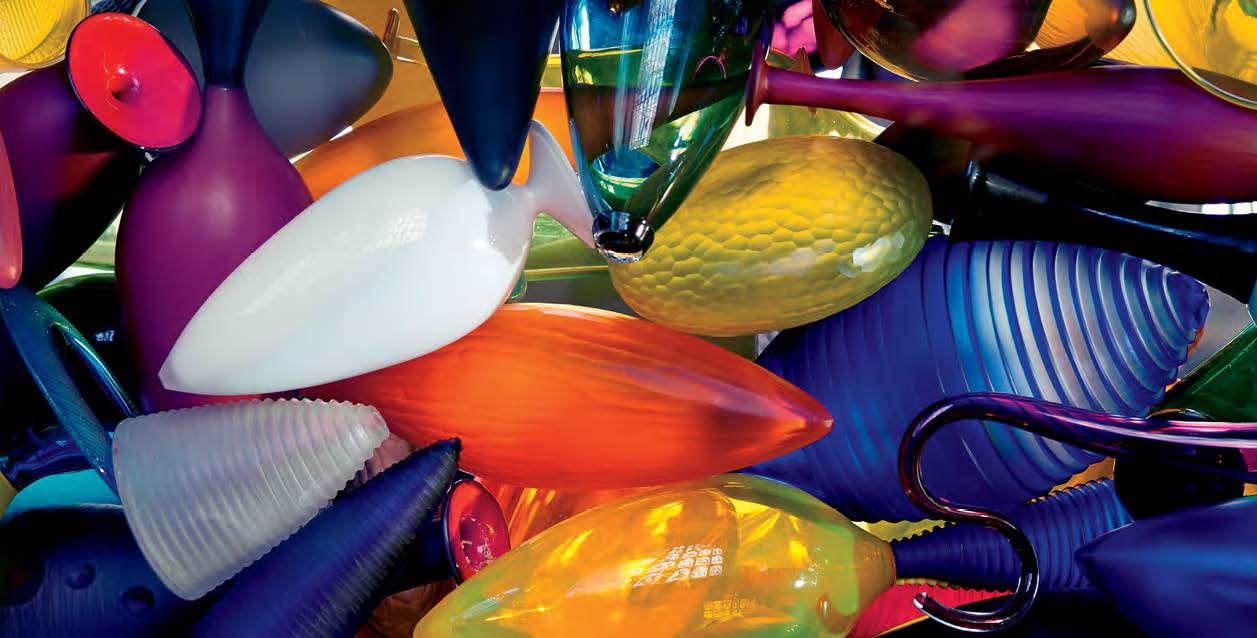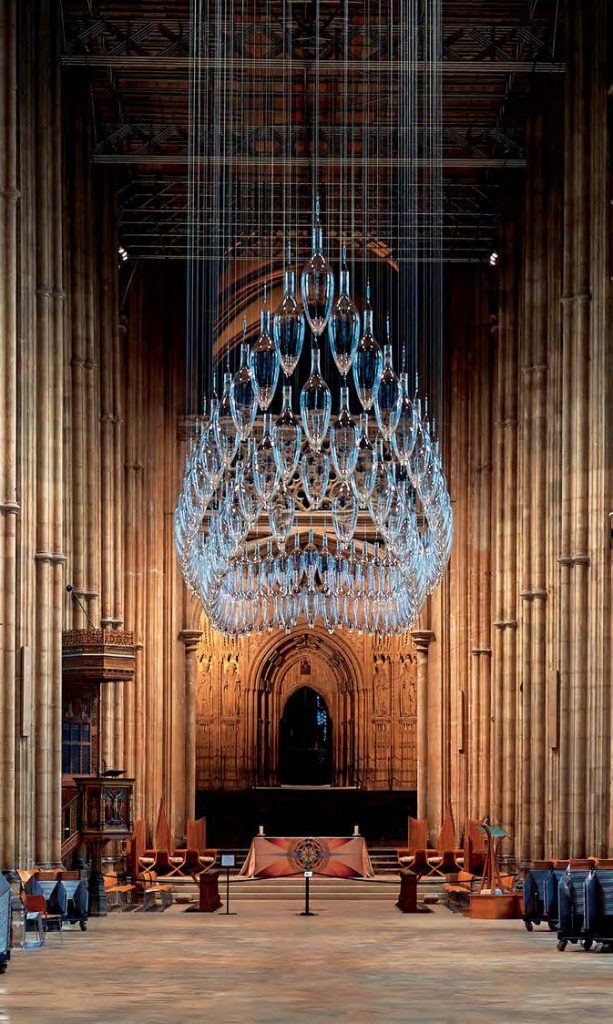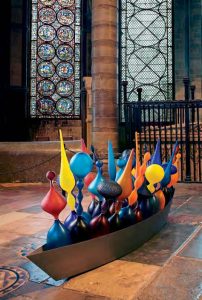
Under an Equal Sky: Baldwin and Guggisberg at Canterbury Cathedral

One hundred elegant, clear glass vessels—amphorae—are suspended from the towering nave of the Canterbury Cathedral, where together they form the shape of a visionary ship, flowing elegantly from stern to prow. The Boat of Remembrance is one of 10 works in an exhibition created by Philip Baldwin ’66 and his wife, Monica Guggisberg.
 Each year, Canterbury Cathedral memorializes the murder, in 1170, of its sainted archbishop, Thomas Becket. Becket’s death transformed the Cathedral into a focus of pilgrimage for people worldwide. From May 6, 2018, through January 6, 2019, Philip and Monica’s exhibition, “Under an Equal Sky,” celebrated not only the 848 years since the archbishop’s death, but also the 100 years since the armistice of 1918. Philip and Monica are glassblowers who learned their craft in Sweden and have worked as a team since 1980, in Sweden, Switzerland, France and now rural Wales. Their installation embraces a scope of ideas as relevant today as in the 12th century. It recognizes our endemic experience with warfare and its consequences, and acknowledges the mighty flow of human migration, the pilgrimage to escape violence or environmental disasters, the homelessness of millions of migrants and refugees, so many of them children.
Each year, Canterbury Cathedral memorializes the murder, in 1170, of its sainted archbishop, Thomas Becket. Becket’s death transformed the Cathedral into a focus of pilgrimage for people worldwide. From May 6, 2018, through January 6, 2019, Philip and Monica’s exhibition, “Under an Equal Sky,” celebrated not only the 848 years since the archbishop’s death, but also the 100 years since the armistice of 1918. Philip and Monica are glassblowers who learned their craft in Sweden and have worked as a team since 1980, in Sweden, Switzerland, France and now rural Wales. Their installation embraces a scope of ideas as relevant today as in the 12th century. It recognizes our endemic experience with warfare and its consequences, and acknowledges the mighty flow of human migration, the pilgrimage to escape violence or environmental disasters, the homelessness of millions of migrants and refugees, so many of them children.
The artists use the “repeating simple forms of boats, amphorae and empty vessels, symbols found across different cultures,” the exhibition catalogue notes, to reckon with some of the most difficult issues of our time while offering aspiration for positive outcomes. Amphorae have carried goods by ship since ancient times, and also served as funeral urns; they symbolize the human journey. And in Christianity, the boat draws on the idea of the Church as a sanctuary. The stunning shapes, textures and colors of empty vessels throughout the exhibition reflect the beautiful diversity among humans, all of us navigating a journey.
The proposition underlying “Under an Equal Sky” is that “we are all bound together,” the artists have written, “that our differences enrich one another’s lives, that community matters. The rising inequality between people concerns us all. We may be born citizens of nation states but we are citizens of the world, too.
 “In choosing this title, we wished to convey the idea that our planet is a unitary living organism whose sky is without prejudice. Living as we do under this generous light equally dispersed throughout our world, we are unavoidably confronted by the bleak contrast it presents—the vast swaths of territory blighted and under siege and the ever-increasing flow of migrants and refugees whose plight this Cathedral community wishes to highlight, as it always has. Their fates, and frankly, ours too, lie increasingly in the balance. There must be a better way . . . . The intent of our exhibition is that people will seek and find the good and the positive.”
“In choosing this title, we wished to convey the idea that our planet is a unitary living organism whose sky is without prejudice. Living as we do under this generous light equally dispersed throughout our world, we are unavoidably confronted by the bleak contrast it presents—the vast swaths of territory blighted and under siege and the ever-increasing flow of migrants and refugees whose plight this Cathedral community wishes to highlight, as it always has. Their fates, and frankly, ours too, lie increasingly in the balance. There must be a better way . . . . The intent of our exhibition is that people will seek and find the good and the positive.”
The exhibition leads viewers throughout the Cathedral, where they will discover Philip and Monica’s beautiful and thought-provoking pieces, crafted of exquisite materials, located simply in meaningful sections of the church. The People’s Wall, located where the exhibition concludes, rejects our current political concept of a wall. Instead, a transparent glass “wall of inclusion,” contains a representation, in colorful, multishaped vessels, of displaced people from around the globe, thriving in the most creative of communities. “This is our paean to a better future,” write Philip and Monica.




